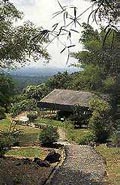 |
Popular
Places |
Lembah
Bujang (Bujang Valley)
 Home
to the most important Hindu-Buddhist kingdom in the Malay Peninsula, Lembah
Bujang dates as far back as the 5th Century. By the 7th Century, it had
become part of the huge Sriwijaya Empire of Sumatra. Lembah Bujang reached
its architectural peak in the 9th and 10th Century; Hindu and Buddhist
temples were scattered all over the area. Archeologists have unearthed
more than 53 temples or "candis" (shrines). The kingdom had traded with
India, Khmer, and Sriwijaya. It was a kingdom that was rich in history,
culture, and trade. Nonetheless, the kingdom crumbled and temples were
deserted with the coming of Islam in the 14th Century. These temples remained
buried in the jungle until British archeologist Quatrich-Wales first excavated
them in 1936. The Muzium Arkeologi Lembah Bujang (Bujang Valley Archeological
Museum) chronicles these excavations. It also displays stone carvings,
pottery shards, and other findings. Behind the museum, visitors will be
treated to the sight of temples or "candis". The most significant and
largest temple would be the 1000-year-old Candi Bukit Batu Pahat. Home
to the most important Hindu-Buddhist kingdom in the Malay Peninsula, Lembah
Bujang dates as far back as the 5th Century. By the 7th Century, it had
become part of the huge Sriwijaya Empire of Sumatra. Lembah Bujang reached
its architectural peak in the 9th and 10th Century; Hindu and Buddhist
temples were scattered all over the area. Archeologists have unearthed
more than 53 temples or "candis" (shrines). The kingdom had traded with
India, Khmer, and Sriwijaya. It was a kingdom that was rich in history,
culture, and trade. Nonetheless, the kingdom crumbled and temples were
deserted with the coming of Islam in the 14th Century. These temples remained
buried in the jungle until British archeologist Quatrich-Wales first excavated
them in 1936. The Muzium Arkeologi Lembah Bujang (Bujang Valley Archeological
Museum) chronicles these excavations. It also displays stone carvings,
pottery shards, and other findings. Behind the museum, visitors will be
treated to the sight of temples or "candis". The most significant and
largest temple would be the 1000-year-old Candi Bukit Batu Pahat.
Gunung
Jerai
 Formerly
known as "Kedah Peak", this forest-clad Gunung Jerai is a massive limestone
outcrop that rises 1200m above sea level. As the highest peak in the state,
it adds a touch of variety to the scenic flat plains seen throughout the
area. Formerly
known as "Kedah Peak", this forest-clad Gunung Jerai is a massive limestone
outcrop that rises 1200m above sea level. As the highest peak in the state,
it adds a touch of variety to the scenic flat plains seen throughout the
area.
Please visit Gunung
Jerai under Highlands
Alor
Setar
 The
capital of Kedah state is approachable from all parts of the Peninsula
by all transport means. Alor Setar has many modern structures and shopping
complexes of historical significance. The
capital of Kedah state is approachable from all parts of the Peninsula
by all transport means. Alor Setar has many modern structures and shopping
complexes of historical significance.
Please visit Alor
Setar under Cities
Top of Page
|
